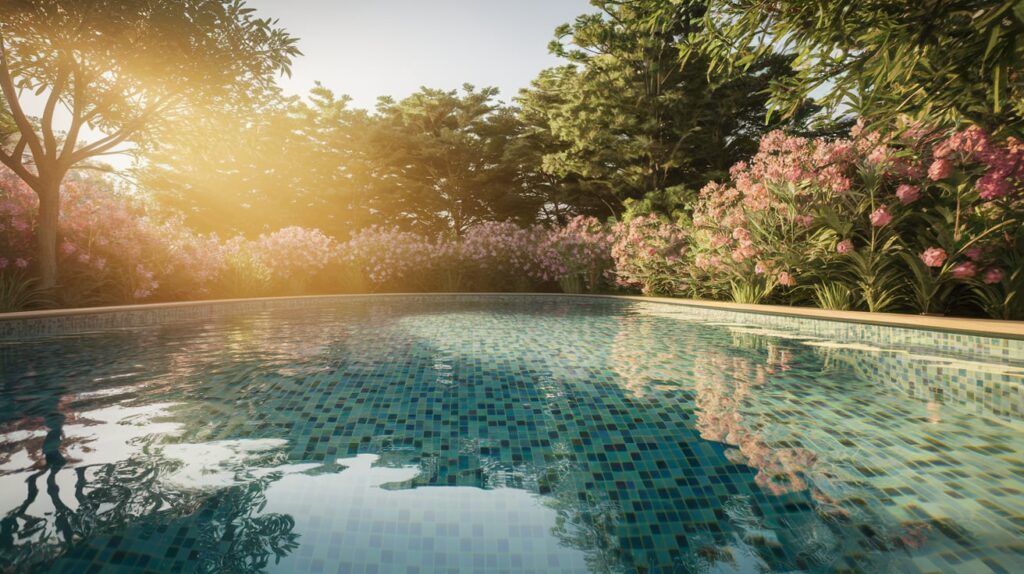Imagine stepping into your backyard, ready to dive into your pool, only to find it overtaken by unsightly green algae. It’s frustrating, isn’t it?
Recommended Best Pool Vacuum for Algae 2025-2026
| Recommendation | Product |
| Best Overall | Bubot 300P Robotic Pool Cleaner |
| Popular Choice | POOL BLASTER Pulse Cordless Pool Vacuum |
| Best Value | Enhulk Pool Vacuum for Above Ground Pool |
| Best Budget | Intex Handheld Pool Vacuum Cleaner |
| Another Excellent Pick | VINGLI Pool Vacuum Cleaner |
But don’t worry, you’re not alone. Many pool owners face this pesky problem. Algae can transform your inviting oasis into a murky mess, but there’s good news – you can reclaim your pool’s sparkling beauty. By understanding the right algae treatment methods, you can ensure your pool remains a crystal-clear haven.
This guide will show you how to tackle algae effectively, so you can enjoy your pool without worry. Dive in and discover how you can keep your pool pristine and inviting.

Types Of Pool Algae
Different types of pool algae include green, yellow, and black algae. Green algae float and make water cloudy. Yellow algae cling to walls and are tougher to remove. Black algae appear as dark spots and are the most difficult to treat.
Effective algae treatment involves regular cleaning and proper chemical balance.
When it comes to maintaining a pristine swimming pool, understanding the types of algae that can invade your oasis is crucial. Algae are tiny organisms that can bloom rapidly, turning your pool water into a murky mess. Knowing the different types of algae helps you tackle them effectively and keep your pool crystal clear. Let’s dive into the three most common types of pool algae and how to manage them.
Green Algae
Green algae are the most common culprits in pool water. They thrive in sunlight and multiply quickly, especially when chlorine levels drop. If you notice your pool water turning cloudy or developing a green tint, it’s likely due to green algae.
To treat green algae, you need to shock your pool with a high dose of chlorine. Scrubbing the walls and floor will help dislodge stubborn colonies. Regularly cleaning your filters is essential, as they can harbor algae spores.
Yellow Algae
Yellow algae, sometimes called mustard algae, are more tenacious. They cling to pool surfaces, often in shady areas, and are resistant to chlorine. If you find yellow patches that resemble pollen or sand, you’re dealing with yellow algae.
Treating yellow algae requires a slightly different approach. Use a specialized algaecide designed for mustard algae. Brush the affected areas thoroughly to remove any residue. Maintaining proper pH and chlorine levels will prevent future outbreaks.
Black Algae
Black algae are the toughest to eliminate. They form dark spots on pool surfaces and have a protective layer that makes them resistant to standard treatments. If you see black or blue-green spots that won’t brush off, it’s likely black algae.
To combat black algae, you’ll need a strong algaecide and some elbow grease. Scrape off the protective layer with a stiff brush before applying treatment. Be consistent with your cleaning routine to prevent regrowth.
Have you ever had a surprise algae outbreak just before a big pool party? It’s a common scenario. Understanding these types can save you from a last-minute scramble. What’s your go-to strategy for keeping algae at bay? Share your tips in the comments!
Causes Of Algae Growth
Warm temperatures and sunlight can cause algae to thrive in pools. Poor circulation and imbalanced chemicals also contribute to growth. Regular maintenance and proper chemical treatments help in controlling algae.
Algae in your pool can be a real headache. It turns your sparkling oasis into a cloudy, green swamp. But understanding the causes of algae growth can help you tackle the problem head-on. Let’s dive into some of the main reasons why algae might be invading your pool.
Imbalanced Chemicals
Keeping your pool’s chemical levels balanced is crucial. When chlorine levels drop, algae can thrive. Have you ever skipped testing your pool water? It’s easy to overlook, especially during busy weeks. Yet, this simple task is vital. Ensure you’re checking and adjusting chlorine and pH levels regularly. A slight imbalance can open the door for algae to set up home.
Poor Circulation
Have you ever noticed stagnant water in your pool? Poor circulation often leads to algae growth. Your pool pump should run several hours a day to keep the water moving. If the water isn’t circulating well, algae can settle and multiply quickly. Inspect your pool pump and filters. Are they working effectively? If not, it might be time for some maintenance or replacement.
Lack Of Maintenance
Regular maintenance is your best defense against algae. Skipping cleaning sessions can lead to grime build-up, creating a perfect environment for algae. Remember that time you were too busy for a quick pool vacuum? Algae remembers too. Set a weekly schedule for brushing, skimming, and vacuuming your pool. Consistency is key in preventing algae from taking over.
Algae growth in your pool is not just an eyesore; it can also be a health hazard. By understanding these causes, you can take proactive steps to maintain a clean and inviting pool. Are you ready to protect your pool from algae? Start by addressing these common issues today.
Preventive Measures
Keeping your pool algae-free requires consistent attention. Algae can quickly ruin the pool experience. Fortunately, effective preventive measures can keep these pesky invaders at bay. Regular cleaning, maintaining proper water chemistry, and ensuring adequate filtration are essential steps.
Regular Cleaning
Brush the pool walls weekly. This prevents algae buildup. Pay attention to corners and steps. Skimming the surface daily removes debris. Use a pool vacuum to clean the floor. Regular cleaning reduces algae chances.
Proper Water Chemistry
Balanced water chemistry is crucial. Test water weekly using a pool test kit. Ensure pH levels stay between 7.2 and 7.8. Maintain chlorine levels between 1 and 3 ppm. Proper chemical balance discourages algae growth. Adjust chemicals promptly if needed.
Adequate Filtration
A well-functioning filter is vital. Run the filtration system daily for 8 to 12 hours. Backwash the filter regularly to clear impurities. Clean the filter as per manufacturer guidelines. Effective filtration keeps water clean and clear. A clean pool filter is an algae deterrent.
Chemical Treatments
Algae treatment for pools keeps water clear and safe. These treatments target algae growth, ensuring a clean swimming environment. Regular use helps maintain pool hygiene, preventing unsightly green spots.
Keeping your pool water crystal clear is a common concern for many pool owners. When algae takes over, it’s crucial to act swiftly with the right chemical treatments. Understanding these treatments can save you time, effort, and ensure your pool is always ready for a refreshing swim. Let’s dive into some effective methods.
Chlorine Shock
Chlorine shock is a powerful method for eradicating algae quickly. It involves adding a high dose of chlorine to your pool. This intense concentration kills algae and other bacteria.
Have you ever noticed your pool looking green after a rainstorm? A chlorine shock can transform it overnight. Make sure to follow the product instructions carefully. Always test the water after treatment to ensure safety.
Algaecides
Algaecides offer another line of defense against algae growth. They are specifically designed to target and kill various types of algae. This treatment works best when used regularly as a preventive measure.
You might wonder if algaecides are necessary if you already use chlorine. While chlorine is effective, combining it with algaecides can provide comprehensive protection. Consider adding it to your routine to maintain a pristine pool.
Ph Adjustments
Maintaining the right pH balance is crucial for any chemical treatment to be effective. Algae thrive in unbalanced water. Regularly testing your pool’s pH can prevent an algae outbreak before it starts.
Have you ever checked your pH levels after noticing algae? A pH adjustment might be all you need. By keeping the pH between 7.2 and 7.6, you create an environment where algae struggle to survive.
Are you ready to tackle algae confidently this season? With these chemical treatments, your pool can remain a sparkling oasis. Remember, consistency is key. Regular maintenance ensures that you spend less time worrying and more time enjoying your pool.
Natural Treatment Options
Algae can turn pool water green and murky. Treating pools naturally involves using eco-friendly methods to clear algae. These options often include mineral-based additives and regular maintenance to keep the pool clean and safe.
Algae can be a persistent nuisance in pools, but what if you could tackle it using natural methods? Many pool owners are turning to eco-friendly solutions that are not only effective but also safe for you and your family. Let’s dive into some simple and natural treatment options that can help maintain your pool’s clarity without the need for harsh chemicals.
###
Baking Soda
Baking soda is more than just a kitchen staple. It can be a powerful ally in maintaining your pool’s pH balance. Sprinkle baking soda into your pool water to combat algae growth effectively.
Why baking soda? It’s gentle on pool surfaces and won’t irritate your skin. Plus, it’s readily available. Imagine the satisfaction of knowing that something so simple can help keep your pool sparkling clean.
###
Vinegar
Vinegar is not just for salads; it can work wonders in your pool too. Use it to clean pool surfaces and remove algae stains. Its acidic nature helps in breaking down algae without introducing toxic chemicals.
Consider pouring some vinegar over a sponge and scrubbing areas affected by algae. It’s a straightforward approach that shows results. Have you tried using vinegar in your pool maintenance routine?
###
Borax
Borax is another eco-friendly solution that can help keep your pool algae-free. It raises the pH level of your pool water, creating an environment that’s less hospitable for algae.
Sprinkle borax directly into the pool and let it do the work. It’s not only effective but also budget-friendly. Could borax be the secret ingredient your pool needs for a clearer tomorrow?
Using these natural options, you can maintain a beautiful pool without compromising on safety or spending a fortune. What are your go-to natural solutions for pool care?
Long-term Maintenance Tips
Keeping your pool free from algae is a constant battle, but the right long-term maintenance tips can make it much easier. Consistent care not only prevents algae growth but also enhances your pool’s overall health. The key is routine inspections, maintaining consistent chemical levels, and adjusting your strategies seasonally. Let’s dive into each of these aspects to keep your pool sparkling clean.
Routine Inspections
Regular inspections are your first line of defense against algae. Make it a habit to check your pool for any signs of algae at least once a week. Look for green or cloudy patches on the water surface. Inspect the pool walls and floor for any slimy feel. This quick check can save you time and money in the long run.
While inspecting, ensure your filters and pumps are functioning efficiently. A clogged filter can become a breeding ground for algae. You might have experienced this once and vowed never to let it happen again. Regularly clean and maintain your equipment to avoid this scenario.
Consistent Chemical Levels
Keeping your pool’s chemical levels balanced is crucial. Test the water regularly to maintain the ideal pH and chlorine levels. It might sound tedious, but it’s a simple step that can drastically reduce algae growth.
Invest in a reliable water testing kit. This allows you to make quick adjustments. Remember that even small changes in chemical levels can lead to big algae problems. You wouldn’t want to invite friends over and discover that your pool has turned into a green swamp.
Seasonal Adjustments
Algae growth can be more aggressive in certain seasons. During warmer months, increase your pool’s chlorine levels slightly. This helps combat the faster algae growth rate. In cooler months, you might need less chlorine, but don’t neglect regular checks.
Consider covering your pool during off-seasons. This prevents debris and leaves from entering the water, reducing algae risk. Have you noticed how a covered pool remains cleaner, saving you from unexpected cleaning marathons when summer hits again?
Engage with your pool. It’s an investment that deserves your attention. What challenges do you face in maintaining your pool? Share your experiences and tips with others, as your insights could be invaluable.
Frequently Asked Questions
What Is The Best Treatment For Algae In A Pool?
Use a pool shock treatment to kill algae quickly. Brush pool surfaces thoroughly to remove residue. Add algaecide for prevention. Ensure filtration system runs continuously. Maintain balanced pool chemistry with regular testing. Follow manufacturer instructions for all products used.
Should I Put Algaecide Or Shock First?
Add shock to your pool first to eliminate bacteria and contaminants. After 24 hours, apply algaecide to prevent algae growth. This order ensures effective pool treatment and maintains water clarity. Always follow product instructions for best results.
Does Chlorine Shock Get Rid Of Algae?
Yes, chlorine shock effectively eliminates algae in pools. It kills algae by raising chlorine levels rapidly. Regular maintenance and proper filtration enhance its effectiveness. Always follow manufacturer instructions for best results. Rebalance water chemistry after treatment to prevent algae regrowth.
How Do I Get Rid Of Algae In My Pool Without Algaecide?
Brush the pool walls and floor thoroughly. Increase filtration and run it continuously. Shock the pool with chlorine. Maintain balanced pH levels between 7. 2-7. 6. Use a pool vacuum to remove debris. Ensure proper circulation by cleaning skimmers and pump baskets regularly.
Conclusion
Algae treatment keeps your pool clean and safe. Regular maintenance is key. Choose the right method for your pool type. Chemical solutions work fast and are effective. Natural treatments are eco-friendly options. Both can help control algae growth. Keep filters clean and maintain water balance.
Test water regularly to prevent algae. A clean pool enhances enjoyment and health. Don’t let algae spoil your fun. Take action and enjoy a clear pool. Happy swimming!






